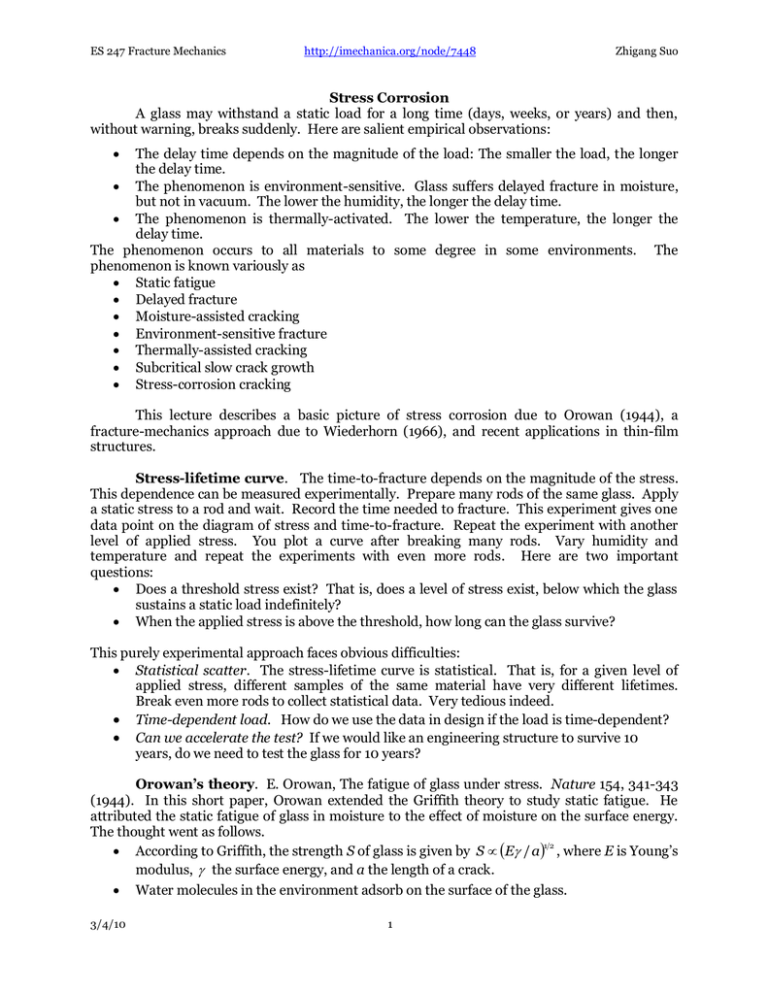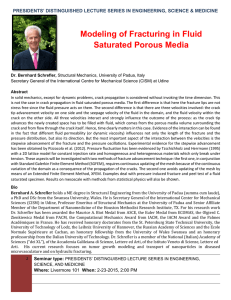Stress Corrosion
advertisement

ES 247 Fracture Mechanics http://imechanica.org/node/7448 Zhigang Suo Stress Corrosion A glass may withstand a static load for a long time (days, weeks, or years) and then, without warning, breaks suddenly. Here are salient empirical observations: The delay time depends on the magnitude of the load: The smaller the load, the longer the delay time. The phenomenon is environment-sensitive. Glass suffers delayed fracture in moisture, but not in vacuum. The lower the humidity, the longer the delay time. The phenomenon is thermally-activated. The lower the temperature, the longer the delay time. The phenomenon occurs to all materials to some degree in some environments. The phenomenon is known variously as Static fatigue Delayed fracture Moisture-assisted cracking Environment-sensitive fracture Thermally-assisted cracking Subcritical slow crack growth Stress-corrosion cracking This lecture describes a basic picture of stress corrosion due to Orowan (1944), a fracture-mechanics approach due to Wiederhorn (1966), and recent applications in thin-film structures. Stress-lifetime curve. The time-to-fracture depends on the magnitude of the stress. This dependence can be measured experimentally. Prepare many rods of the same glass. Apply a static stress to a rod and wait. Record the time needed to fracture. This experiment gives one data point on the diagram of stress and time-to-fracture. Repeat the experiment with another level of applied stress. You plot a curve after breaking many rods. Vary humidity and temperature and repeat the experiments with even more rods. Here are two important questions: Does a threshold stress exist? That is, does a level of stress exist, below which the glass sustains a static load indefinitely? When the applied stress is above the threshold, how long can the glass survive? This purely experimental approach faces obvious difficulties: Statistical scatter. The stress-lifetime curve is statistical. That is, for a given level of applied stress, different samples of the same material have very different lifetimes. Break even more rods to collect statistical data. Very tedious indeed. Time-dependent load. How do we use the data in design if the load is time-dependent? Can we accelerate the test? If we would like an engineering structure to survive 10 years, do we need to test the glass for 10 years? Orowan’s theory. E. Orowan, The fatigue of glass under stress. Nature 154, 341-343 (1944). In this short paper, Orowan extended the Griffith theory to study static fatigue. He attributed the static fatigue of glass in moisture to the effect of moisture on the surface energy. The thought went as follows. 12 According to Griffith, the strength S of glass is given by S E /a , where E is Young’s modulus, the surface energy, and a the length of a crack. Water molecules in the environment adsorb on the surface of the glass. 3/4/10 1 ES 247 Fracture Mechanics http://imechanica.org/node/7448 Zhigang Suo A waster-adsorbed surface of glass has a lower surface energy than a clean surface of glass. To affect fracture, water molecules must migrate to the front of the crack and assist in breaking atomic bonds. Both processes take time, and are thermally activated. The crack extends slowly. When the crack reaches a critical length, it grows rapidly, leading to sudden fracture. A cartoon of the stress-assisted reaction of water and glass. The H2O molecules react with the Si-O-Si bonds, so the glass form two surfaces covered with monolayers of H-O-Si. The full molecular detail of this reaction is still not resolved. Other material-environment pairs are even less understood. A pragmatic approach: division of labor, using a combination of experiments and computations. Obreimoff’s experiment. J.W. Obrimoff, The splitting strength of mica, Proc. Roy. Soc. Lond. A127, 290-297 (1930). We have discussed this experiment in class and in a homework problem. Oberimoff used a beam-like configuration to determine the fracture energy of mica. He found that the fracture energy of mica tested in a vacuum is more than 10 times that tested in a moist air. This observation was used by Orowan to explain a difference of factor 3 in the strength of glass tested in a vacuum and in a moist air. Wiederhorn’s work. Starting in 1966, Wiederhorn initiated a series of work to apply the fracture mechanics to stress corrosion inn glasses and ceramics. Here is an early account: S.M. Wiederhorn, Moisture assisted crack growth in ceramics. The International Journal of Fracture Mechanics 4, 171-177 (1968). He measured the crack velocity as a function of the applied load. He cut a sample with a crack, loaded it in a controlled environment, and measured the crack velocity V. The external boundary conditions determine the energy release rate G. Wiederhorn used the doublecantilever beams. Of course, it is completely equivalent to use specimens of any other shapes. The V-G curve. Recall again the slogan: the same K-history, the same crack-tip process. For a given material and a given environment, the V-G curve is a material property. The V-G curve is typically plotted with G as the horizontal axis in linear scale, and V as the vertical axis in logarithmic scale. Sketch the curves on the blackboard. Leading features: Threshold, Gth . When G Gth , the crack does not grow. The value Gth is very difficult to determine in experiments. A state of chemical equilibrium. Fracture energy for fast crack growth, Gc . Region I. Sensitive to load, temperature, chemical potential of the environmental molecules. Reaction-limited process. Region II. Insensitive to load. Sensitive to temperature, chemical potential of the environmental molecules. Transport-limited process. 3/4/10 2 ES 247 Fracture Mechanics http://imechanica.org/node/7448 Zhigang Suo Region III. Fast crack growth. Correspond to a crack in vacuum. Thermally-activated process. In principle, one can obtain the entire V-G curve by using a single specimen. A fitting formula in Region I. For the slow growth region, Region I, a fitting formula for the V G function is G V V0 sin h 1 . Gth The mechanical boundary conditions enter through G. The effect of temperature and the chemical potential of the environmental molecules enter through the three fitting parameters V0 , and Gth . Proof test. A.G. Evans and S.M. Wiederhorn, Proof testing of ceramic materials—an analytical basis for failure prediction. Int. J. Fracture 1974, 10, 379. Cracks are assumed to preexist on the surface of a given engineering component, and grow slowly under a static stress. Fracture mechanics suggests the following procedure for design. Determine the material property V G curve by experimental measurement. Obtain the loading curve Ga by solving boundary value problems. Obtain an upper bound of the initial crack size ai in the component by a proof test. If Gai Gth , the crack will not grow, and the component is immortal. If Gai Gth , the crack will grow. The lifetime of the component is determined by integrating the ordinary differential equation: da Material curve: V G , dt Loading curve: G Ga . Within this approach, one can also handel change in load and environment as a function of time. Determine V-G curve by using a channel crack in a thin film. R.F. Cook and E.G. Liniger, Stress-corrosion cracking of low-dielectric-constant spin-onglass thin films. K.W. McElhaney and Q. Ma, Investigation of moisture-assisted fracture in SiO2 films using a channel cracking technique. Acta Materialia 52, 3621-3629 (2004). Use the V-G curve to measure G in a component. G. Xu, J. He, Z. Suo, Experimental determination of crack driving forces in integrated structures. Proceedings of the 7th International Workshop on Stress-Induced Phenomena in Metallization, Austin, Texas, 1416 June 2004. (http://www.seas.harvard.edu/suo/papers/163.pdf). Further readings M.F. Ashby and D.R.H. Jones, Engineering Materials 2, Chapter 18. The chapter gives a concise engineering background. B. Lawn, Fracture of Brittle Solids, 2nd Ed., Cambridge University Press, 1993. Chapter 5. Section 10.2. R.H. Dauskardt, M. Lane, Q. Ma, N. Krishna, Adhesion and debonding of multi-layer thin film structures. Engineering Fracture Mechanics 61, 141-162 (1998). J.J. Vlassak, Y. Lin and T.Y. Tsui, Fracture of organosilicate glass in thin films: environmental effects. Materials Science and Engineering A391, 159-174. 3/4/10 3 ES 247 Fracture Mechanics http://imechanica.org/node/7448 An e-mail from Qing Ma. From: Qing Ma qing.ma@intel.com To: Zhigang Suo suo@seas.harvard.edu Date: Friday, 31 July 2009, 12:30 PM Subject: Predictable cracks Zhigang: How are you? If you still teach fracture mechanics, these cracks (in letters) could be interesting. They seem to follow theory well, students might be able to solve the paths. Best, Qing 3/4/10 4 Zhigang Suo






